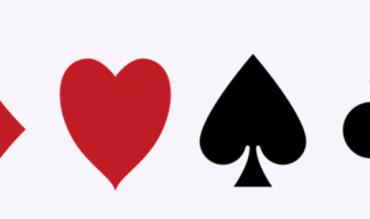Playing cards are the #1 resource for all casino card games. For the most part, they are standardised, with a set of suits and card values. A standard deck consists of 52 cards. These are divided up into four suits – diamonds, hearts, spades, and clubs. Each suit features 13 cards. These include Ace, 2, 3, 4, 5, 6, 7, 8, 9, 10, Jack, Queen, and King.
Card values may differ from game to game. For example, in blackjack, Aces count as one or 11, and 10, Jack, Queen, and King have a value of 10. In baccarat, 10, Jack, Queen, and King have zero value. In Deuces Wild Video Poker, 2s are wild, and they can assume any value to help players form a winning hand.
Standard decks of cards typically include Wild cards – Jokers. American card producers introduced them in 1867. 13 years later, the British introduced them. Yet their introduction has often led to their exclusion in virtually all casino card games.
It's fascinating how playing cards are used, but what are the origins of these entertainment attractions?
The Big Reveal: Intro to Playing Cards
The physical construction of rectangular playing cards includes layers of cardboard or paper bound together in a robust fashion. The playing cards are coated with a glossy plastic sheen (introduced in the 20th century) to safeguard them against damage, marking, moisture, warping, and overuse.
All playing cards are uniform in size and shape, and decks of cards are designed in a way that they're easily held in the palm of your hand. The corners of each card are rounded to prevent them from fraying.
The design of playing cards can certainly vary, but a standard format exists. For example, one side of the playing cards features the card value and the suit. For example, Jack of hearts, 10 of spades, or Ace of diamonds. Players can see the value of the card irrespective of which way the cards are held.
On the other side of a playing card is an intricate pattern – identical for all the cards. This obscures the value of the cards from being revealed to the dealer and other players at the table. A group of historians believe that the four suits signify the classes of medieval society – diamonds for merchants, hearts for clergy, spades for nobility, and clubs for peasants.
Casino cards are elegant in their simplicity. These sleek and stylish accoutrements are indispensable to their respective games. Players receive cards from the croupier or dealer. You can only see the cards dealt to you, the dealer's upcard in blackjack, the player's hand and the banker's hand in baccarat, or the community cards in Texas Hold 'em poker. Players can never see cards held by other players at the table.
International decks of cards are standardised with 52 cards, four suits, and 13 ranked cards from 2 through Ace. There is strong evidence to suggest that spades represent swords from the Spanish. This gives the Spaniards bragging rights regarding the first use of card suits.
As for ranks, the King trumps all cards except for the Ace. These cards can assume the highest value or the lowest value, depending on the requirements of the hand.
The Amazing Origins of Playing Cards
Much of what we enjoy in the West originated in the East! That much is true for playing cards too. In ancient China, players used dominoes for entertainment purposes. There is no distinction between dominoes and cards in this country. The 10th-century Chinese literature refers to dominoes or playing cards.
Indeed, it is the same word that is used to describe them. By some accounts, the Chinese lay claim to the 'Game of Leaves' played as early as the ninth century. Brits attest to the earliest mention of playing cards in an official registry, but the French claim the tarot card and later the carte à Jouer.
In Europe, playing cards appeared on the scene in the 1370s. Countries such as Spain and Italy likely were the first to showcase playing cards. Given that much of the trading activity taking place at the time was conducted by way of merchants on the high seas, scholars concur that playing cards probably arrived from North Africa, with the Islamic Mamluk Dynasty, based in Egypt.
The original European playing cards were hand-painted, and they were regarded as precious keepsakes by society’s well-heeled. Royalty and aristocracy likely sought out these accoutrements and used them at prestigious gatherings, parties, and hobnobbing. Indeed, King Charles VI of France purchased a deck of cards for his amusement.
A now lost archive reputedly indicates a payment of 56 sols parisiens to a noted painter named Gringonneur to create this luxurious keepsake. In the early days, playing cards were the elites' express domain. Over time, these valuable cards made their way across Europe. Land-based trade is largely credited with the popularisation of playing cards in Europe.
Despite their appeal, playing cards were hard to come by. It was difficult and time-consuming to create hand-painted cards on a scale that could satisfy the growing demand. Then the Germans invented a printing press using wood blocks in the 15th century. It sharply reduced the costs of producing playing cards. The French were also hard at work in the printing press, and they created painting stencils in the 1480s. Recall that stencils are hollowed outlines, making it easy to paint in the gaps to create shapes, figures, and designs.
These French stencils gave rise to the iconic symbols we know so well today: carreau (diamonds), Coeur (hearts), pique (spades), and trefle (clubs). Once publishers created the standardised deck of cards, game designers formulated various card games suited to specific types of players. As a result, cards have been used for gambling purposes for hundreds of years. Yet, churches repeatedly denounced playing cards, and the civic authorities routinely banned certain games.
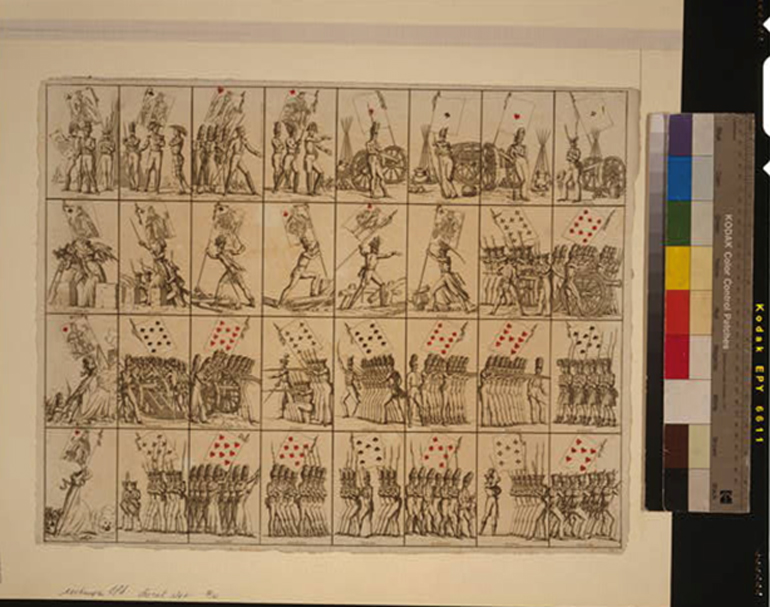
Source: Library of Congress "Jeu de drapeaux" (i.e., game of flags)] https://www.loc.gov/pictures/resource/cph.3g09838/
That didn't stop the finance minister of King Louis XIV – Cardinal Mazarin – from using public office to transform the majestic Palace of Versailles into a veritable card-playing casino paradise in the 17th century.
Such was the seriousness of card making that certain countries enacted laws which imposed stiff penalties on anyone other than a government-approved printer from manufacturing playing cards. Anyone caught forging cards were subject to punitive measures such as fines, detention and imprisonment, or the death penalty.
The diamonds, hearts, spades, and clubs are known as pips. These symbols have symbolic meaning, but they were by no means the only symbols used to represent a hierarchy of values. Other motifs routinely included cultural references, geographic imagery, wildlife pecking orders, heavenly bodies in the universe, alchemy, wizards, witches, sorcerers et al.
Much of this was incredibly fascinating to 16th century Europe. It may come as a surprise to learn that French and British decks of cards always showcase the four kings, Alexander the Great, Julius Caesar, David, and Charles. Among the Queens, the ladies enjoyed less reverence. The likes of Argine, Judith, Rachel, and Pallas were featured on many decks of cards.
Little-Known Facts about Playing Cards – Truly Fascinating!
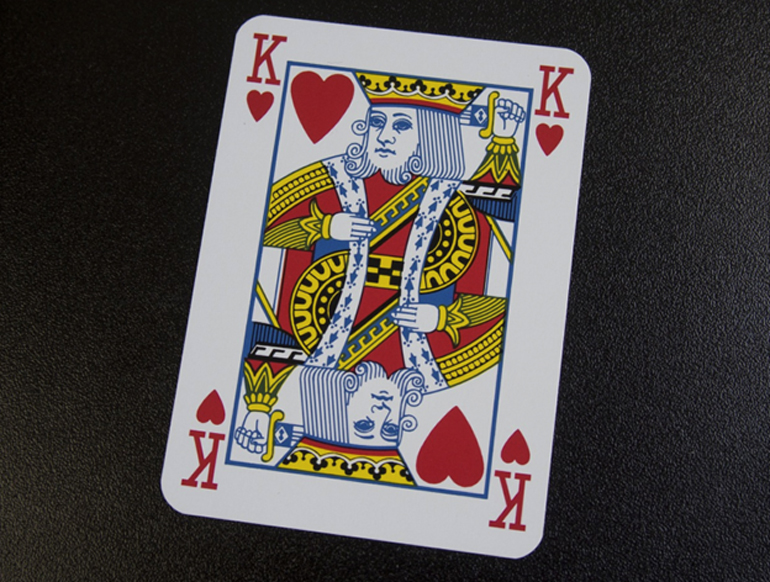
Source: Pixabay No Attribution Required
The vaunted Ace came into being in 1765. The same year, England started taxing playing card sales. The authorities stamped the Ace to indicate that sellers had paid the tax. Anyone caught forging (counterfeiting) an Ace could be put to death. That's why the Ace card has such a striking design to this day.
Many card players are blissfully unaware that the King of hearts is the only King without a moustache – it's true – take a look! Now, take a closer look at the King of hearts – he appears to be committing suicide by taking his sword in his left hand and forcing it through the side of his head. This oddity is easily explained by printing errors that simply became accepted in the mainstream.
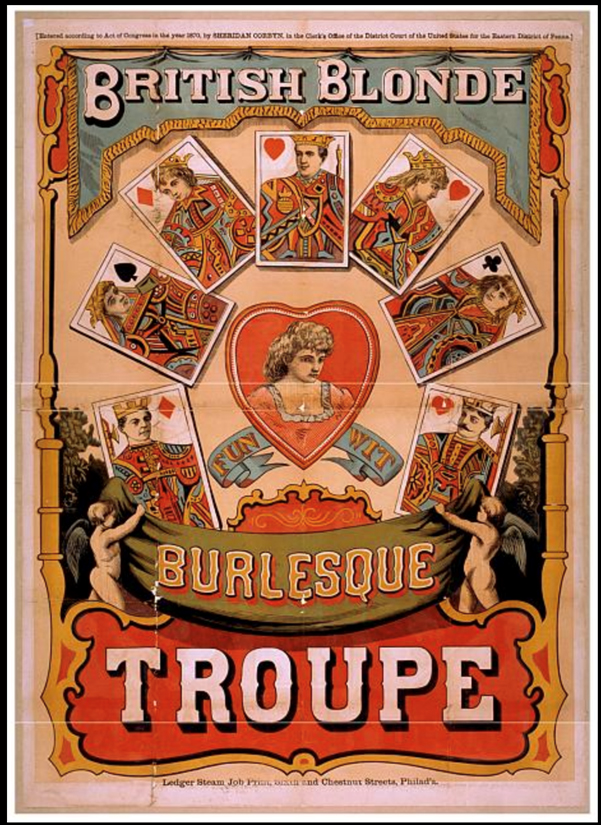
Source: British Blonde Burlesque Troupe Philad'a: Ledger Steam Job Print, c1870.https://www.loc.gov/pictures/resource/var.1994/
Throughout the ages, playing cards have assumed different designs. Circa 1800, French playing cards featured soldiers bearing flags with the rank and suit of the playing card. Such intricate designs attest to the high value associated with these artistic creations. Fast forward to the 20th century – playing cards remain as coveted as ever. It's a specialised market that features a small group of corporations that now control the line share of the market. Many of the smaller, traditional card designers no longer exist.
A Chronology: Playing Cards Through the Ages
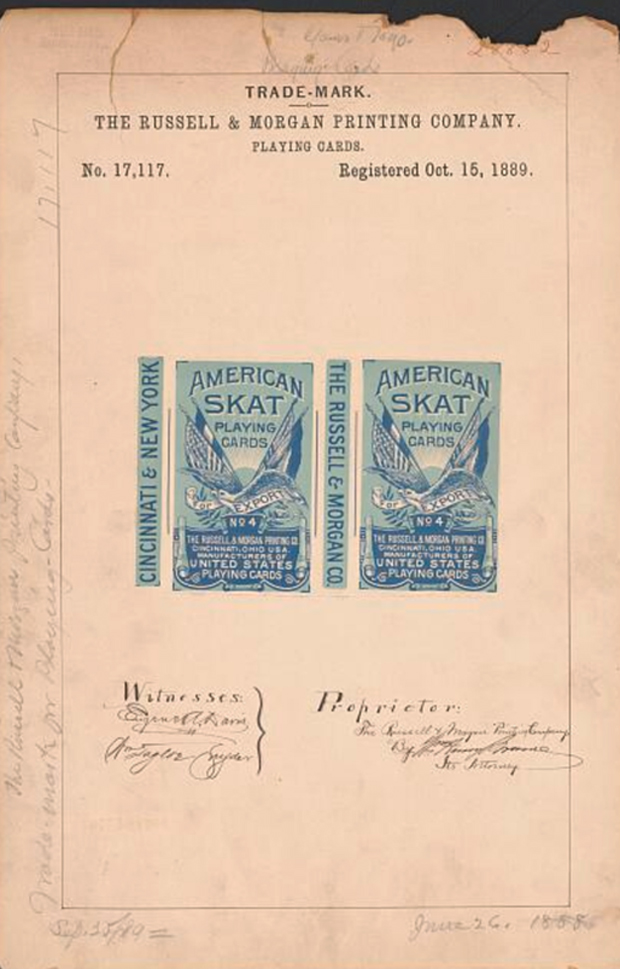
Source: Trademark registration by The Russell & Morgan Printing Company for American Skat Playing Cards brand Playing Cards https://www.loc.gov/pictures/resource/trmk.1t17117/
- 868 CE – Su E of China describes the leaf game played by Princess Tom Cheng. The Tang dynasty makes the first reference in recorded history to playing cards.
- 1005 CE – a Chinese writer named Ouyang Xia alludes to the popularity of playing cards with paper instead of traditional scrolls.
- 1367 CE – Switzerland officially bans playing cards.
- In the 1400s – various pips are introduced on cards.
- 1480 – Decks of cards now feature diamonds, hearts, spades and clubs in France.
- In the 1500s – A company known as Rouen from France begins producing playing cards for England.
- In the 1790s – Before the French Revolution, the King was the most valuable playing card. Now the Ace pips the King.
- 1867 – Cincinnati, Ohio company Russell, Morgan & Company produces playing cards.
- The 1870s – The Joker appears as the highest card in the game of Euchre.
- 1939 – A Mameluke deck of cards is discovered by Leo Mayer, dating back seven centuries.
- 1942 – The United States Playing Card Company produced Bicycle® Spotter Decks to help in the war effort by identifying enemy combatants and vehicles and providing prisoners of war with maps.
- 1966– A pair of Lieutenants corresponded with the United States Playing Card Company to create decks containing only Aces of spades – these terrified the superstitious Vietcong.
Valuable Keepsakes
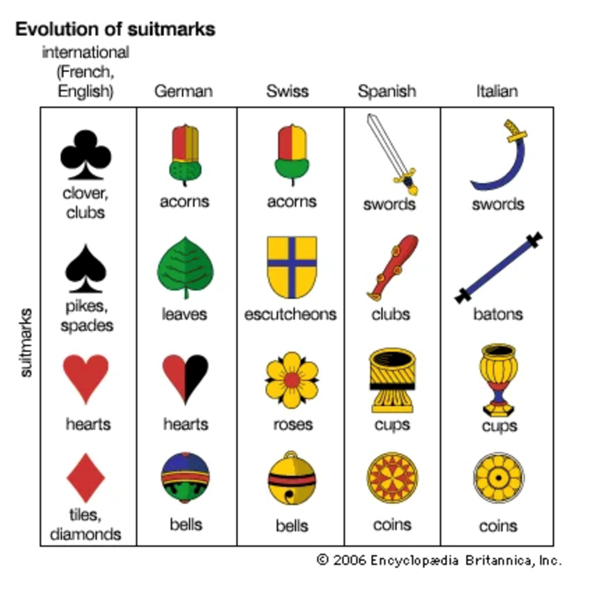
Source: Britannica National Decks of Playing Cards https://www.britannica.com/topic/playing-card/National-decks
Indeed, old playing cards were less about playing games than they were about a valuable investment in a work of art. Since playing cards were heavily taxed, and the Ace was proof of tax payment, these keepsakes remained under lock and key before mass production started taking place. Nevertheless, players and collectors would often compare the artistic skills of playing card creators. The most elegant, beautiful, and desirable designs would fetch a 'pretty penny.'
For half a millennium, the backs of playing cards were plain. Then came Thomas De La Rue & Company of England. This printing and stationery company showcased lithographic designs, such as stars, dots and patterns to print onto the back of playing cards. This made it much more difficult for cards to be marked by cheaters and card sharks.
There remains plenty of conjecture about whom we should credit for playing cards. It's an arena filled with smoke and mirrors. While we don't know the origins for certain, the Chinese, French, Indians, Italians, British, Spanish, Germans and Egyptians certainly have a big part to play. It's a truly global effort, with an assortment of contributions to the standardised deck of playing cards we know today.
Playing cards represented a tableau of society, a ranking system with the peasantry, gentry, politicians, and royals determining who creates the winning hand!
